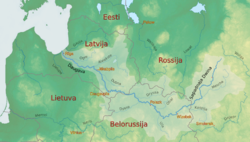
Back Daugava Afrikaans ዳውጋቫ ወንዝ Amharic نهر دفينا Arabic نهر دفينا ARZ Ríu Daugava AST Dauqava Azerbaijani دائوقاوا چایی AZB Көнбайыш Двина Bashkir Daugova BAT-SMG Заходняя Дзвіна Byelorussian
| Daugava Western Dvina | |
|---|---|
 The drainage basin of the Daugava | |
| Native name |
|
| Location | |
| Country | Belarus, Latvia, Russia |
| Physical characteristics | |
| Source | Valdai Hills |
| • location | Penovsky District, Tver Oblast, Russia |
| • coordinates | 56°52′16″N 32°31′44″E / 56.871°N 32.529°E |
| • elevation | 221 m (725 ft) |
| Mouth | Gulf of Riga |
• location | Riga, Latvia |
• coordinates | 57°3′42″N 24°1′50″E / 57.06167°N 24.03056°E |
• elevation | 0 m (0 ft) |
| Length | 1,020 km (630 mi)[1] |
| Basin size | 87,900 km2 (33,900 sq mi)[1] |
| Discharge | |
| • average | 678 m3/s (23,900 cu ft/s) |
The Daugava (Latgalian: Daugova; German: Düna) or Western Dvina (Russian: Западная Двина, romanized: Zapadnaya Dvina; Belarusian: Заходняя Дзвіна; Estonian: Väina; Finnish: Väinäjoki) is a large river rising in the Valdai Hills of Russia that flows through Belarus and Latvia into the Gulf of Riga of the Baltic Sea. The Daugava rises close to the source of the Volga. It is 1,020 km (630 mi) in length,[1] of which 352 km (219 mi) are in Latvia[2] and 325 km (202 mi) in Russia. It is a westward-flowing river, tracing out a great south-bending curve as it passes through northern Belarus.
Latvia's capital, Riga, bridges the river's estuary four times. Built on both riverbanks, the city centre is 15 kilometres (9.3 mi) from the river's mouth and is a significant port.
- ^ a b c "Main Geographic Characteristics of the Republic of Belarus. Main characteristics of the largest rivers of Belarus". Land of Ancestors. Data of the Ministry of Natural Resources and Environmental Protection of the Republic of Belarus. 2011. Archived from the original on Jan 15, 2014. Retrieved 27 September 2013.
- ^ "Gruberts D. "Daugava". Nacionālā enciklopēdija". Nacionālā enciklopēdija. Retrieved 11 August 2022.
© MMXXIII Rich X Search. We shall prevail. All rights reserved. Rich X Search